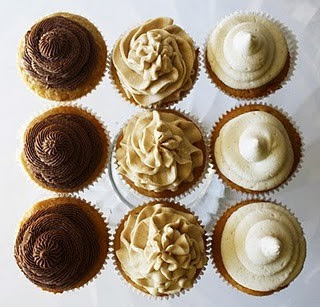There are a lot of kinds of edible cake coverings. Faced with nekkid cake, the cake decorator can choose to cover it with any or a combination of: buttercream, royal icing, flat icing, fudge, glaze, fondant, gumpaste, sugar paste, ganache, molding chocolate, whipped cream, meringue, mousse...
Generally, frosting types can be sorted into six types.
- Buttercream is made by mixing (you guessed it) butter (or margarine) and powdered sugar with a liquid (frequantly milk), and sometimes a flavoring such as vanilla extract. Think of the frosting on grocery store cakes, and you'll have an idea of the texture: smooth, creamy, and easily spread.
- Royal icing is a harder, stiffer consistancy; in cake decorating, it is extremely useful for any kind of delicate lace work, hanging loops, or flowers. Unlike buttercream, it will hold its shape, and won't smear. Unfortunately, it is also relatively fragile. The basic recipe is meringue powder with a liquid (I tend to use water).
- Ganache is essentially chocolate melted into butter and cream. It is extreme versatile, and very rich. Heated to a liquid, it can be poured over cakes to form a shiny glaze. Left to sit at room temperature and then beaten, it becomes a fluffy, rich filling; chillen and beaten, it becomes thick, stiff, and excellent for rolling into truffles. If poured flat and chilled until only slightly soft, it can be used for cut-out chocolate shapes (but I wouldn't recommend it for anything that doesn't lie flat).
- Glazes are the simpliest icings, made by mixing powdered sugar and water, or a juice (lemon glazes, for example, are powdered sugar and lemon juice). It is generally poured or drizzled, and hardens into a shiny, hard crust. Because the flavor can be made as subtle or a strong as you want, these can be a great accent to a pastry, or used to add a tang of flavor between layers of filling on a cake
- Fondant is popular on sculpted cakes and wedding cakes, and undoubtedly familiar to anyone who watches cake shows. The basic recipe is a mixture of sugar, water and either glucose or cream of tartar. Before it dries, it rather resembles PlayDoh in texture, and can be kneaded, rolled, stretched and shaped. Rolled flat, it can be draped over and shaped against the contours of a cake. Within this category I'll also include things like molding chocolate, which can be softened and worked into shapes, and gumpaste, which is similar to fondant, but includes gum tragacanth (gum tex), and is more rigid when dried. This makes it especially good for delicate shapes and flowers, since it can be rolled much thinner and tends to hold it's shape. (Fondant, in a warm room, can soften again).
- Whipped/Meringues involve egg whites, and are beaten or cooked until the frosting is light and fluffy. While these can make for great additions to desserts, they tend to break down over time.
The exterior, however, tends to divide cake decorators into one of two camps: those who work with buttercream, and those who work with fondant. Frequently, each side can come up with a long list of reasons why their chosen medium is superior, but when it comes down to it, I feel that it's a bit like the difference between painting and sculpting: both are artistic mediums, but require slightly different skill sets.
Pros and Cons
So, why use one over the other?
Fondant makes things, to a certain extent, easy: it can be shaped and rolled into three-dimensional decorations. Gum-Tex powder can be worked in to give it support, and it is far more likely to survive a trip from bakery to plate, since it won't smear. When it's used to cover cakes, fondant--when applied well--creates an absolutely smooth, matte surface that doesn't require a steady hand with the spatula. In most cases, it holds color well. It also stores longer than other types of frosting.
 |
| All fondant, from Colette Cakes |
Buttercream, on the other hand, can be easily made at home, and is more likely to be a crowd-pleaser in terms of flavor and familiarity. Personally, I like it because it's an easy matter to pipe designs onto the cake surface, and does not need an extra amount of counter space for rolling. It can create highly delicate patterns, and apart from coloring, doesn't need much prep work. When it comes to writing, I personally don't have time to punch out and place individual letters.
 |
| All buttercream, from Some Crust Bakery |
So then, which one's better?
Again, it depends on your strengths in decorating (have a steady hand? Try buttercream piping. Rather work with your hands? Go the fondant route) and personal taste.
 |
| Of course, buttercream can make for some pretty awesome 3D cakes, too. |
For most of my life, I've been a buttercream kind of girl, but that's mainly due to the preferences of the people I most often bake for (family and friends).
I've recently been working more with fondant--for the sceptics out there, think of it as any other medium, and give it a try! Remember, with store-bought frosting, not all brands are equal.
Stay tuned for a follow up and review of fondant brands!
















































